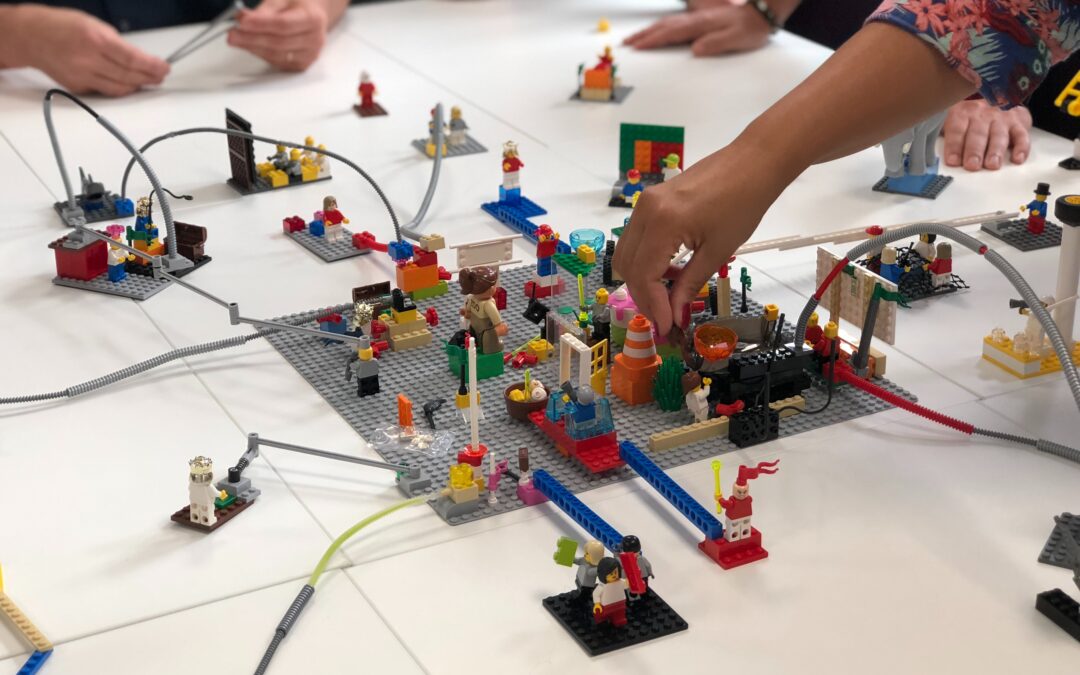
by Robyn Bolton | Jul 29, 2020 | Customer Centricity, Innovation, Strategy
Over the past several weeks, I’ve kicked off innovation projects with multiple clients. As usual, my clients are deeply engaged and enthusiastic, eager to learn how to finally break through the barriers their organizations erect and turn their ideas into real initiatives that generate real results.
Things were progressing smoothly during the first kick-off until a client asked, “Who’s my customer?”
I was shocked. Dumbfounded. Speechless. To me, someone who “grew up” in P&G’s famed brand management function and who has made career out of customer-driven innovation, this was the equivalent of asking, “why should I wear clothes?” The answer is so obvious that the question shouldn’t need to be asked.
Taking a deep breath, I answered the question and we moved on.
A few days later, the question was asked again. By a different client. In a different company. A few days later, it was asked a third time. By yet a different client. In yet a different company. In a completely different industry!
What was going on?!?!?
Each time I gave an answer specific to the problem we were working to solve. When pressed, I tried to give a general definition for “customer” but found that I spent more time talking about exceptions and additions to the definition rather than giving a concise, concrete, and usable answer.
That’s when it struck me – Being “customer-driven” isn’t enough. To be successful, especially in innovation, you need to focus on serving everyone involved in your solution. You need to be “stakeholder-driven.”
What is a customer?
According to Merriam-Webster, a customer is “one that purchases a commodity or service.”
Makes perfect sense. At P&G, we referred to retailers like WalMart and Kroger as “customers” because they purchased P&G’s products from the company. These retailers then sold P&G’s goods to “consumers” who used the products.
But P&G didn’t focus solely on serving its customers. Nor did it focus solely on serving its consumers. It focused on serving both because to serve only one would mean disaster for the long-term business. It focused on its stakeholders.
What is a stakeholder?
Setting aside Merriam-Webster’s first definition (which is specific to betting), the definitions of a stakeholder are “one that has a stake in an enterprise” and “one who is involved in or affected by a course of action.”
For P&G, both customers (retailers) and consumers (people) are stakeholders because they are “involved in or affected by” P&G’s actions. Additionally, shareholders and employees are stakeholders because they have a “stake in (the) enterprise.”
As a result, P&G is actually a “stakeholder-driven” company in which, as former CEO AG Lafley said in 2008, the “consumer is boss.”
How to be a stakeholder-driven organization
Focusing solely on customers is a dangerous game because it means that other stakeholders who are critical to your organization’s success may not get their needs met and, as a result, may stop supporting your work.
Instead, you need to understand, prioritize, and serve all of your stakeholders
Here’s how to do that:
- Identify ALL of your stakeholders. Think broadly, considering ALL the people inside and outside your organization who have a stake or are involved or affected by your work.
- Inside your organization: Who are the people who need to approve your work? Who will fund it? Who influences these decisions? Who will be involved in bringing your solution to life? Who will use it? Who could act as a barrier to any or all of these things?
- Outside your organization: Who will pay for your solution? Who will use your solution? Who influences these decisions? Who could act as a barrier?
- Talk to your stakeholders and understand what motivates them. For each of the people you identify by asking the above questions, take time to actually go talk to them – don’t email them, don’t send a survey, actually go have a conversation – and seek to understand they’re point of view. What are the biggest challenges they are facing? Why is this challenging? What is preventing them from solving it? What motivates them, including incentives and metrics they need to deliver against? What would get them to embrace a solution? What would cause them to reject a solution?
- Map points of agreement and difference amongst your stakeholder. Take a step back and consider all the insights from all of your stakeholders. What are the common views, priorities, incentives, or barriers? What are the disagreements or points of tension? For example, do your buyers prioritize paying a low price over delivering best-in-class performance while your users prioritize performance over price? Are there priorities or barriers that, even though they’re unique to a single stakeholder, you must address?
- Prioritize your stakeholder by answering, “Who’s the boss?” Just as AG Lafley put a clear stake in the ground when he declared that, amongst all of P&G’s stakeholders, that the consumer was boss, challenge yourself to identify the “boss” for your work. For medical device companies, perhaps “the boss” is the surgeon who uses the device and the hospital executive who has the power to approve the purchase. For a non-profit, perhaps it’s the donors who contribute a majority of the operating budget. For an intrapreneur working to improve an internal process, perhaps it’s the person who is responsible for managing the process once it’s implemented. To be clear, you don’t focus on “the boss” to the exclusion of the other stakeholders but you do prioritize serving the boss.
- Create an action plan for each stakeholder. Once you’ve spent time mapping, understanding, and prioritizing the full landscape of your stakeholder’s problems, priorities, and challenges, create a plan to address each one. Some plans may focus on the design, features, functions, manufacturing, and other elements of your solution. Some plans may focus on the timing and content of proactive communication. And some plans may simply outline how to respond to questions or a negative incident.
Yes, it’s important to understand and serve your customers. But doing so is insufficient for long-term success. Identifying, understanding, and serving all of your stakeholders is required for long-term sustainability.
Next time you start a project, don’t just ask “Who is my customer?” as “Who are my stakeholders?” The answers my surprise you. Putting those answers into action through the solutions you create and the results they produce will delight you.
Originally published on March 23, 2020 on Forbes.com

by Robyn Bolton | Jun 24, 2020 | Customer Centricity, Innovation, Tips, Tricks, & Tools
Innovation doesn’t start with an idea. It starts with a problem. Sometimes those problems are easy to observe and understand but, more often, those problems are multi-layered and nuanced. As a result, you need a multi-layered and nuanced approach to understanding them.
You need to have EPIC Conversations.
EPIC stands for Empathy, Perspective, Insights, and Connection. As my clients have experienced, conversations rooted in these elements consistently produce unexpected, actionable, and impactful insights capable of getting to the root of a problem and shining a light on the path to a solution (and meaningful business results).
EMPATHY for the people with whom you’re talking
According to Brene Brown, empathy is connecting to the emotion another person is experiencing without requiring us to have experienced the same situation.”
For example, I have a friend who struggles to stay focused and deliver on deadlines. I can empathize with her because, while I have no problem focusing or delivering on deadlines, I know what it’s like to struggle with something that other people think is easy.
Take the time to connect with people’s emotions, to understand not just what they’re feeling but also why they’re feeling that way and to connect with the experiences in your life and work that led you to feel that way, too.
See things from their PERSPECTIVE:
When we’re working on something – a project, a product, even a task – it gets a great deal of our time, attention, and energy. But it can lead us to over-estimate how important the work is to others.
Instead, ask people about the topic you’re interested in AND all the topics and activities around it. Take the time to understand where the things you care about fall into your customers’ priority list
For example, when I worked on developing and launching Swiffer, all I thought about was cleaning floors. One day, we had to decide whether to source the hair for the dirt that would be used in product demos from people, yaks, or wigs. We obsessed over this decision, debating which hair would “resonate” the most with consumers. Turns out, consumers didn’t spend a lot of time analyzing the hair in the demo dirt, they only cared that it was picked up immediately by Swiffer.
Be open to INSIGHTS
Most people use conversations to get confirmation that their ideas and recommendations are good ones. They’ll spend time explaining and convincing and very little time listening. And they definitely don’t like surprises.
This is wrong. The most successful and impactful conversations as those in which you are surprised, in which you get an unexpected piece of information and has an insight, an “a-ha!” moment.
Years ago, while conducting research with people who self-identified as environmentalists, my team spoke with a woman who had the most sustainable house I’d ever seen. Everything was reused, recycled, or composted and they generated most of their own power. But, in the garage was a huge yellow HUM-V. It would have been easy to dismiss it as an anomaly, until we asked about the contradiction and she explained that the reason she owned a HUM-V was the same reason she and her family lived such a sustainable lifestyle: her highest priority was keeping her kids safe. At home, that meant doing everything possible to help the planet, but on the roads, that meant driving around in a tank.
CONNECT with the person you’re speaking with
It’s tempting to jump right into the conversation, to ask the questions that brought you together. But that’s like proposing on the first date – you’re not going to get the answer(s) you want.
The best conversations aren’t information transactions, they’re trust building exercises. Take time to get to know each other. Make small talk, talk about the traffic and the weather, share a bit about yourself and ask about them. Throughout the conversation, share a bit about yourself, commiserate over shared frustrations, and laugh at silly stories.
By sharing a bit about yourself, the person you’re talking to will share a bit of themselves, they’ll feel comfortable admitting to things that might not make sense, and to the feelings and rationalizations that drive their behaviors.
EPIC Conversations can happen with anyone anywhere from customers in focus group rooms to employees in conference rooms. You don’t need an executive mandate to have one, so have one today and let me know how it goes!
Originally published on February 10, 2020 on Forbes.com

by Robyn Bolton | May 13, 2020 | Customer Centricity, Innovation, Stories & Examples, Strategy
I took my last flight on Friday, March 13, two days after the president’s first address to the nation about COVID-19.
It was a JetBlue flight from Charlotte, NC back home to Boston. And it was awesome!
Setting aside the fact that I was wearing disposable gloves and wiping down every surface with Clorox wipes, I felt like I was flying private. I was the only person in my row, with no one in the row ahead of or behind me. Snacks and drinks were plentiful. The stewards were friendly and attentive. Even the boarding process was swift and orderly.
But when stay-at-home orders went into effect the following Monday and I shared my travel story with clients, they were aghast. How could I take such risks? Did I feel safe? Did I wear a mask?
Their reactions surprised me. After all, these executives are frequent travelers, even road warriors they travel so much. Yet the fear in their voices revealed a changing perception of travel. What was once a necessary evil for work and an efficient solution for vacation had, in just 3 days, become a senseless risk.
In the 2 months since that flight, the airline industry has been rocked. Consider:
- 94% drop in US commercial airlines’ passenger volume
- 80% decrease in US private jet flights
- 75% decrease in the number of worldwide commercial flights per day
- 80% decline in the global daily number of flight searches
- 61% increase in the amount of time between booking and traveling
That last stat – 61% increase in the amount of time between booking and traveling – indicates that people don’t expect to fly any time soon. But is that expectation a reaction to the drastic measures taken to flatten the curve or is it a sign of changing travel habits?
Many experts and industry associations are looking to data about the airline industry’s recovery post-9/11 and the 2008 global financial crisis. According to data from Airlines for America, it took 3 years for passenger volume and revenue to return to pre-9/11 levels and approximately 7 years to recover to pre-2008 financial crisis levels.
Here’s the harsh truth – we cannot possibly know what will happen next. 9/11 and the 2008 financial crisis were fundamentally different events than what we’re experiencing now.
So while I understand why people are looking to these past events – data offers a sense of comfort and control over the future – using data from them is pointless. It offers a warm snuggly illusion that things won’t change that much and a return to the old days is inevitable.
Instead of looking to the past for answers, we need to look to physics.
Newton’s 3rd Law, to be precise. It states that for every action, there is an equal and opposite reaction.
By looking at the actions that airlines, and regulatory and legislative bodies, are currently considering, it’s possible to predict customers’ equal and opposite reactions and, as a result, what the new normal could look like.

Photo by Nadine Shaabana on Unsplash
Action: Travelers who cross state or country borders must quarantine for 14-days unless they can prove that they are COVID-19 negative
Reaction: People will limit their travel to within their home states or countries
Most US states and many countries have 14-day mandatory quarantines in place for people traveling into their jurisdictions. Given that most trips last less than two weeks, these restrictions essentially make most travel impractical.
Some places, like Hong Kong and Vienna, are trying to lessen that barrier by testing arriving passengers at the airport and, if they test negative for COVID-19, exempting them from quarantine.
But until a vaccine is widely available, “travel is likely to return first to domestic markets with ‘staycations,’ then to a country’s nearest neighbors before expanding across regions, and then finally across continents to welcome the return of journeys to long-haul international destinations,” according to Cecilia Rodriguez, a senior contributor to Forbes.

Photo by Dino Reichmuth on Unsplash
Action: Prices increase due to fewer flights, reduced capacity
Reaction: Demand decreases as vacations become road trips and business travelers continue to use virtual meeting technology
According to research by Longwoods International, a research firm focused on the tourism industry, 82% of people traveling in the next 6 months have changed their travel plans. 22% of these people have changed from flying to driving. “Our clients are a little hesitant to get on an airplane right now,” Jessica Griscavage, director of marketing at McCabe World Travel in McLean, Virginia, told CNBC. “We’re already preparing for the drive market for the remainder of the year, and probably into 2021.”
In conversations I’ve had with business clients, the shift isn’t from air to road travel, the shift is more drastic – from traveling to not traveling. For most large companies, business hasn’t stopped or even slowed. Instead, it’s shifted to technologies like Zoom and Microsoft Teams. As people become more comfortable working “virtually,” these solutions will become far more attractive and just as effective as hopping on a plane.

Photo by CDC on Unsplash
Action: 4-hour pre-flight processing to ensure that all bags are sanitized, and all passengers are healthy
Reaction: Business travelers will choose private flights or fractional jet ownership over commercial air travel
The average business trip is approximately 3 days long according to Travel Leaders Corporate, an award-winning leader in business travel. With most days packed with meetings, executives will have neither the time nor the patience to devote half-a-day to check-in, security and health screening, and boarding.
Instead, they’ll opt for private or private-like offerings such as NetJets that offer an expedited check-in, screening, and boarding process.

Photo by JC Gellidon on Unsplash
Action: Longer flight turnarounds due to the need to sanitize planes
Reaction: Demand (and prices) for direct flights will increase while demand to get to places that don’t offer direct flights will decrease
Consultants often joke about the “Misery Tax” – the premium that clients in hard reach location have to pay to make it “worth the firm’s wile” to serve them. Although that may seem crass, there’s no debating that direct flights are significantly easier and less painful than ones that require connections.
The pain of connecting flights, however, is likely to go through the roof as the 30-minute turn-around times that airlines have been chasing become nearly impossible due to increased cleaning and sanitation guidelines. Gone will be the days when travelers worried about making their connections. Instead, they’ll worry about how to fill the hours between flights.
In fact, it’s likely that the misery of a given itinerary will shift from being a “tax” passed on to clients to a filter that business and leisure travelers will use when deciding where to travel.

Photo by Sharon McCutcheon on Unsplash
Action: Airlines will use the need for more screening and sanitizing to justify more fees
Reaction: People will fly only when needed, instead opting for other, cheaper, and easier convenient options.
With $82B in additional revenue from add-on fees, airlines aren’t going to pull back from charging for “extras.” Instead, the need for more passenger screening, social distancing, and control over what is allowed in the cabin, will inspire even more add-on fees.
For example, airline industry consulting firm, Simplifying, predicts that airlines will no longer allow passengers to pick their seats but will instead assign seats to ensure proper social distancing and offer passengers the opportunity to pay for premium seats and/or keep the seat next to them empty.
Other options under consideration are banning carry-on baggage (which conveniently increases the number of bags checked and therefore the revenue from checked-bag fees) and selling safety kits containing face masks, disposable gloves, and cleaning wipes.
Already tired of being nickel-and-dimed, travelers are unlikely to willingly pay extra for required services and, as a result, are more likely to be open to alternatives such as car trips or virtual face-to-face meetings.

Photo by JESHOOTS.COM on Unsplash
There will always be demand for air travel.
But it may take generations for demand to pre-COVID levels.
Unlike 2001 and 2008, air travelers have options beyond commercial air carriers. Wealthy and business travelers can opt for private jets or services offering fractional ownership. Businesses, already eager to cut costs, will be more open to virtual face-to-face meetings. Families can re-discover the adventure of road trips and the creativity of staycations.
It is the availability of these comparable options combined with the invisible threat of disease that will cause people to re-think their habits and default options and slow the airline industry’s recovery. If it ever fully recovers at all.










